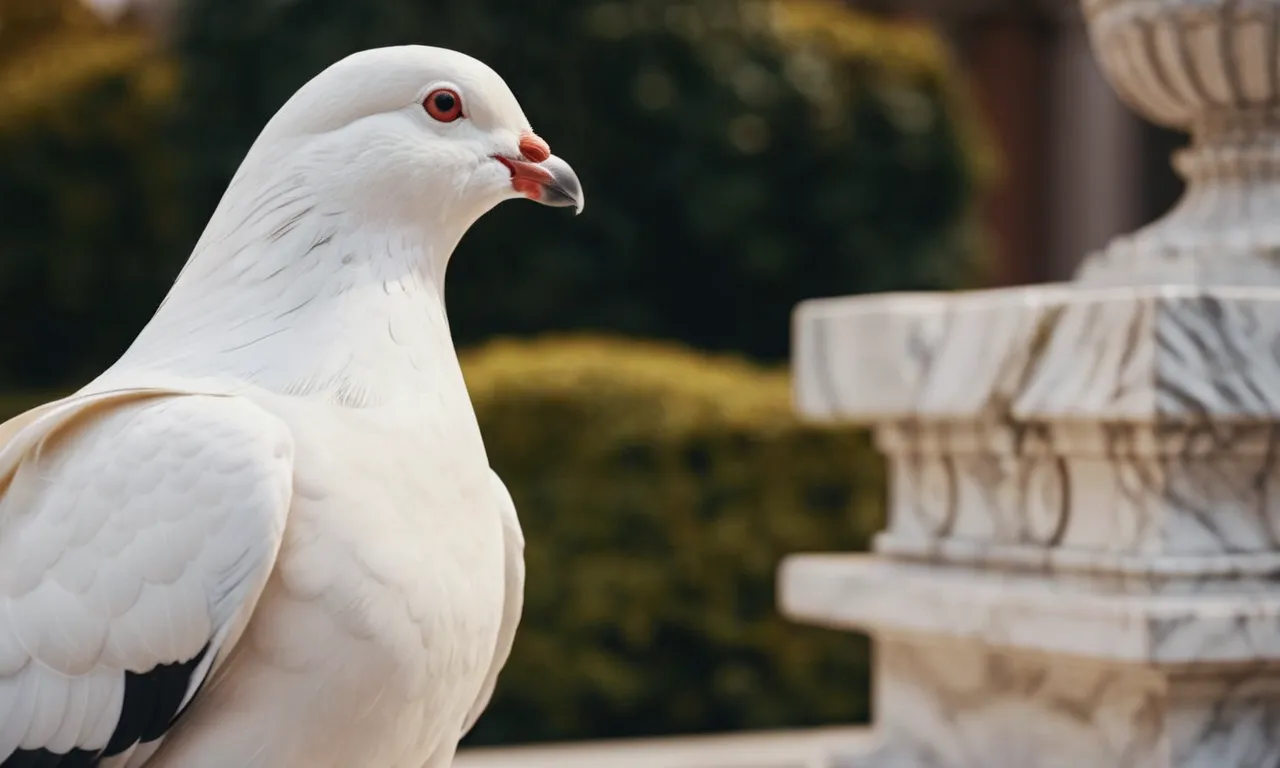White Pigeon Meaning: Unveiling The Symbolism And Significance
In the vast tapestry of symbolism and spiritual significance, the white pigeon holds a revered place, captivating the imagination of cultures across the globe. These graceful winged creatures have long been associated with peace, purity, and divine messages, making their presence a subject of intrigue and fascination.
If you’re short on time, here’s a quick answer to your question: The white pigeon is a powerful symbol of peace, love, and spiritual enlightenment. Its pure white feathers represent innocence, purity, and a connection to the divine realm.
Encountering a white pigeon is often seen as a sign of hope, new beginnings, and the presence of angelic or spiritual guidance.
In this comprehensive article, we will delve into the rich symbolism and cultural significance of the white pigeon, exploring its representation across various belief systems, folklore, and spiritual traditions.
From its association with peace and love to its role as a messenger of the divine, we will unravel the multifaceted meanings and interpretations that have captivated humanity for centuries.
The Symbolism of White Pigeons
Throughout history, white pigeons have been revered as symbols of profound significance, transcending mere physical form to embody deep spiritual and cultural meanings. These graceful birds have captured the hearts and imaginations of people across diverse civilizations, serving as powerful representations of some of humanity’s most cherished ideals.
Peace and Harmony
Perhaps the most widely recognized symbolism associated with white pigeons is their representation of peace and harmony. Since ancient times, these birds have been released as gestures of goodwill and unity, their pure white feathers acting as a visual metaphor for the cessation of conflict and the promotion of tranquility.
In fact, according to the United Nations, the release of white pigeons has become a iconic tradition during the International Day of Peace celebrations, symbolizing humanity’s collective aspiration for a world free from violence and strife.
Purity and Innocence
The pristine white color of these birds has long been associated with purity and innocence. In many cultures, white pigeons are seen as embodiments of these virtues, representing the untainted and unblemished nature of the soul.
Their gentle demeanor and graceful movements further reinforce this symbolism, making them revered symbols of spiritual cleanliness and moral uprightness. This association has been particularly prominent in religious contexts, where white pigeons have been used in rituals and ceremonies to signify the purification of the spirit.
Spiritual Enlightenment
Beyond their physical manifestation, white pigeons are often interpreted as messengers of spiritual enlightenment and divine guidance. Their ability to soar effortlessly through the skies has led many cultures to associate them with the transcendence of earthly limitations and the attainment of higher planes of consciousness.
In some belief systems, the appearance of a white pigeon is seen as a sign from the divine, beckoning individuals to embark on a journey of self-discovery and spiritual growth.
New Beginnings and Hope
The symbolism of white pigeons extends to the realm of new beginnings and hope. Their association with purity and innocence makes them fitting representations of fresh starts and the promise of better times ahead.
The release of white pigeons is often a ceremonial act marking significant life events, such as weddings or the birth of a child, symbolizing the hope and optimism that accompany these milestones. Additionally, their ability to navigate vast distances has led to their symbolic connection with the concept of homecoming, embodying the longing for a safe and welcoming haven.
In essence, the symbolism of white pigeons is a testament to the enduring power of symbols in human culture. These graceful birds have transcended their physical form to become iconic representations of some of humanity’s most cherished ideals, serving as reminders of our capacity for peace, purity, enlightenment, and hope.
As we continue to explore the depths of their symbolic significance, white pigeons remain a timeless and captivating presence, inspiring us to strive for a world where these noble virtues reign supreme.
Cultural and Religious Significance
The white pigeon has long been revered across various cultures and religions, symbolizing peace, purity, and spiritual enlightenment. Its graceful presence has captured the hearts and minds of countless people, transcending geographical boundaries and belief systems.
Here, we delve into the rich cultural and religious significance of this majestic bird.
Christianity and the Holy Spirit
In Christianity, the white pigeon is often associated with the Holy Spirit. According to the Bible, when Jesus was baptized by John the Baptist, the Holy Spirit descended upon him “like a dove” (Matthew 3:16).
This symbolic event has led many Christians to view the white pigeon as a representation of the Holy Spirit, symbolizing divine guidance, peace, and spiritual renewal. The dove’s gentle nature and its association with the olive branch further reinforce its symbolism of peace and reconciliation.
Buddhism and the Dove of Peace
In Buddhism, the white pigeon is revered as a symbol of peace and non-violence. The Buddha himself is said to have been surrounded by white pigeons at his birth, and the bird is often depicted in Buddhist art and iconography.
The Buddhist tradition emphasizes the importance of compassion and ahimsa (non-violence towards all living beings), making the white pigeon a fitting emblem for these values. Many Buddhist temples and monasteries maintain flocks of white pigeons as a reminder of these teachings and as a way to foster a peaceful and harmonious environment.
Ancient Greek and Roman Mythology
In ancient Greek and Roman mythology, the white pigeon held a significant place. It was considered sacred to the goddess Venus (Aphrodite in Greek mythology), who was often depicted with a white pigeon by her side or in her hand.
The bird was seen as a symbol of love, fertility, and beauty, reflecting the goddess’s domains. Additionally, the white pigeon was associated with the messenger god Hermes (Mercury in Roman mythology), as these birds were often used to carry messages in ancient times.
Native American Traditions
Among many Native American tribes, the white pigeon is regarded as a sacred and highly respected bird. In some traditions, it is believed that the white pigeon carries the souls of the departed to the afterlife, representing the transition from this world to the next.
The bird’s ability to fly high and its pure white color are seen as symbolic of the spiritual realm and the journey of the soul. In the Navajo tradition, the white pigeon is revered as a messenger from the Great Spirit, bringing blessings and guidance to the people.
Across these diverse cultural and religious contexts, the white pigeon has emerged as a powerful symbol, transcending boundaries and touching the hearts of people from all walks of life. Its enduring presence in art, literature, and spiritual traditions serves as a testament to the profound impact this graceful bird has had on human civilization.
White Pigeons in Folklore and Legends
Throughout history, white pigeons have held a special place in the folklore and legends of various cultures around the world. These graceful birds have been revered as messengers of the divine, symbols of love and fidelity, and even harbingers of omens and superstitions.
Messengers of the Divine
In many ancient civilizations, white pigeons were considered sacred and were often associated with deities and spiritual realms. For instance, in Greek mythology, white doves were believed to be messengers of Aphrodite, the goddess of love and beauty.
Similarly, in Christianity, the white dove is a symbol of the Holy Spirit, carrying messages from the divine. According to Genesis 8:8-12, Noah released a white dove to search for land after the great flood, and its return with an olive branch signified God’s covenant with humanity.
Symbols of Love and Fidelity
Beyond their spiritual significance, white pigeons have also been celebrated as symbols of love and fidelity. In ancient Rome, newly married couples would release a pair of white pigeons to symbolize their eternal love and commitment.
This tradition still persists in many cultures today, with white doves being released at weddings as a symbol of unity and fidelity. According to a survey by TheKnot.com, over 60% of couples in the United States incorporate a dove release ceremony into their wedding celebrations.
Omens and Superstitions
While white pigeons have been revered for their positive associations, they have also been the subject of various omens and superstitions throughout history. In some cultures, the appearance of a white pigeon was considered a harbinger of good luck or a sign of impending change.
However, in others, it was seen as an omen of death or misfortune. For example, in ancient Rome, if a white pigeon landed on a house, it was believed to foretell the death of the homeowner. In contrast, in Chinese folklore, white pigeons are seen as symbols of peace, prosperity, and longevity.
Whether viewed as messengers of the divine, symbols of love, or omens of fortune, white pigeons have captured the imagination of people across the globe for centuries. Their enduring presence in folklore and legends serves as a testament to the profound impact these graceful birds have had on human culture and spirituality.
As we continue to explore the fascinating world of symbolism, the white pigeon remains a captivating subject, reminding us of the rich tapestry of beliefs and traditions that have shaped our understanding of the natural world.
Encountering a White Pigeon: Interpretations and Meanings
Spotting a white pigeon is an event that often sparks curiosity and wonder, as these feathered creatures are widely regarded as symbols of peace, purity, and spiritual guidance. In many cultures and belief systems, the appearance of a white pigeon is interpreted as a sign from the divine, carrying profound messages and insights.
Spiritual Guidance and Messages
According to various spiritual traditions, white pigeons are believed to represent the connection between the earthly realm and the heavenly realms. They are seen as messengers of the divine, bringing forth guidance, wisdom, and clarity during times of uncertainty or inner turmoil.
Some believe that encountering a white pigeon is a sign to pay attention to your intuition and inner voice, as it may be guiding you toward a path of enlightenment or personal growth. For instance, the website SpiritSanctuary.com suggests that white pigeons can symbolize the presence of guardian angels or spiritual guides, offering protection and divine intervention.
Overcoming Challenges and Obstacles
In many cultures, white pigeons are revered for their ability to navigate long distances and find their way back home, even in the face of adversity. This symbolism translates into a representation of resilience, determination, and the capacity to overcome obstacles.
When you encounter a white pigeon, it may be a sign to persevere through challenging times, trusting that you have the inner strength and guidance to emerge victorious. According to a study by the National Audubon Society, pigeons have an incredible ability to adapt to urban environments, with a 90% survival rate among fledglings in cities.
😮 This resilience serves as a powerful reminder to embrace your own adaptability and resourcefulness when confronted with life’s challenges.
Renewal and Transformation
The pure white color of these feathered creatures is often associated with new beginnings, rebirth, and transformation. Seeing a white pigeon can be interpreted as a sign to embrace change and let go of old patterns or beliefs that no longer serve you.
It may be a nudge from the universe to embark on a journey of self-discovery and personal growth, shedding the metaphorical “old feathers” and emerging as a renewed and transformed version of yourself.
The website Whats-Your-Sign.com notes that white pigeons can symbolize the cycle of life, reminding us that change is inevitable and necessary for our evolution. 🌱
Ultimately, the symbolism and significance of encountering a white pigeon are deeply personal and can resonate differently for each individual. Whether you interpret it as a message of spiritual guidance, a reminder to overcome challenges, or a call for renewal and transformation, the appearance of these winged messengers can be a powerful and awe-inspiring experience.
Embrace the opportunity to reflect on your journey and allow the symbolism of the white pigeon to inspire you on your path to growth and enlightenment. 🕊️
White Pigeons in Art, Literature, and Popular Culture
Artistic Representations
The white pigeon has been a muse for artists across various mediums, from paintings to sculptures. Pablo Picasso’s famous work “La Colombe Blanche” (The White Dove) is a prime example of how these birds have captivated the artistic world.
The painting, created in 1949, symbolizes peace and hope in the aftermath of World War II. Similarly, the renowned sculptor Auguste Rodin immortalized the white pigeon in his bronze sculpture “The Hand of God,” depicting a hand releasing a dove into the air.
In contemporary art, white pigeons have been celebrated by artists like Banksy, who used stencils of these birds as a recurring motif in his street art. According to Tate Modern, his “Girl with Dove” mural, which depicts a young girl releasing a white pigeon, represents a message of hope and innocence amidst the harsh realities of urban life.
Literary Symbolism
White pigeons have graced the pages of literature for centuries, often serving as symbols of peace, purity, and spiritual enlightenment. In the Bible, the white pigeon (or dove) is a recurring motif, representing the Holy Spirit and divine guidance.
One of the most famous literary references is from the book of Genesis, where a dove returns to Noah’s ark with an olive branch, signaling the end of the great flood.
In modern literature, authors have continued to weave the symbolism of white pigeons into their works. For instance, in the novel “To Kill a Mockingbird” by Harper Lee, the character Miss Maudie compares the innocent and gentle Boo Radley to a “mockingbird” and a “white pigeon.”
This comparison highlights the purity and vulnerability of these creatures, drawing a parallel to the book’s themes of innocence and injustice.
Pop Culture References
White pigeons have also found their way into popular culture, often serving as icons of peace and love. In the 1960s, the anti-war movement embraced the white pigeon as a symbol, with activists releasing these birds during protests as a powerful statement against violence.
The iconic photograph of a young woman placing a flower into the barrel of a National Guardsman’s rifle during an anti-war protest, with white pigeons flying in the background, remains a lasting image of the era.
In music, the white pigeon has been celebrated in songs like “White Pigeon” by The Temptations and “White Dove” by Scorpions. The latter’s lyrics, “Like a white dove, you bring the hope of peace,” encapsulate the bird’s symbolic significance as a harbinger of tranquility and harmony.
Additionally, the use of white pigeons in ceremonies, such as weddings and funerals, has become a popular tradition, representing the release of the soul or the beginning of a new chapter in life.
Conclusion
The white pigeon, with its pristine feathers and graceful presence, has captivated the human imagination for centuries, transcending cultural boundaries and belief systems. Its symbolism as a messenger of peace, purity, and spiritual enlightenment has resonated deeply with people across the globe, inspiring artistic expressions, literary works, and cultural traditions.
Whether encountered in the physical world or through symbolic representations, the sight of a white pigeon evokes a sense of hope, renewal, and divine guidance. Its presence serves as a reminder to embrace peace, cultivate inner purity, and remain open to the transformative power of spiritual awakening.
As we continue to explore the rich tapestry of symbolism and significance surrounding the white pigeon, we are reminded of the profound connections that exist between the natural world and the realms of spirituality, mythology, and human experience.
This enduring symbol invites us to embrace the universal values of love, harmony, and enlightenment, transcending boundaries and uniting us in a shared appreciation for the profound beauty and wisdom found in nature’s messengers.








